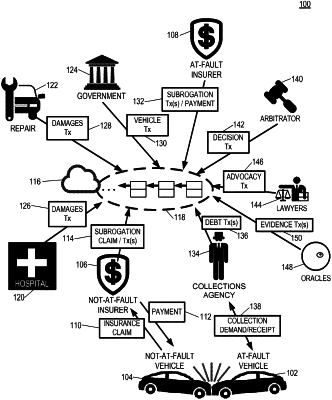| CPC G06Q 40/08 (2013.01) [G06F 16/183 (2019.01); G06F 16/29 (2019.01); G06F 16/90335 (2019.01); G06Q 10/10 (2013.01); H04L 9/0637 (2013.01); H04L 9/3247 (2013.01); H04L 63/101 (2013.01)] | 20 Claims |

|
1. A computer-implemented method for interacting with a distributed ledger maintained by a plurality of participants, the method comprising:
monitoring, at one or more processors, transactions on the distributed ledger;
identifying, at the one or more processors, a transaction related to a subrogation claim;
analyzing, at the one or more processors, the transaction related to the subrogation claim;
generating, at the one or more processors, a recommended subrogation resolution using a machine learning algorithm including determining a subrogation amount for an at-fault insurer, and a not-at-fault insurer;
transmitting, at the one or more processors, a transaction including the recommended subrogation resolution to a smart contract stored on the distributed ledger; and
identifying a subrogation claimant with a first cryptographic public key, and identifying a subrogation defendant with a second cryptographic public key; and, subsequently, sending data including a message signed by private keys corresponding to the first and second public keys identifying the subrogation claimant and the subrogation defendant in the smart contract.
|